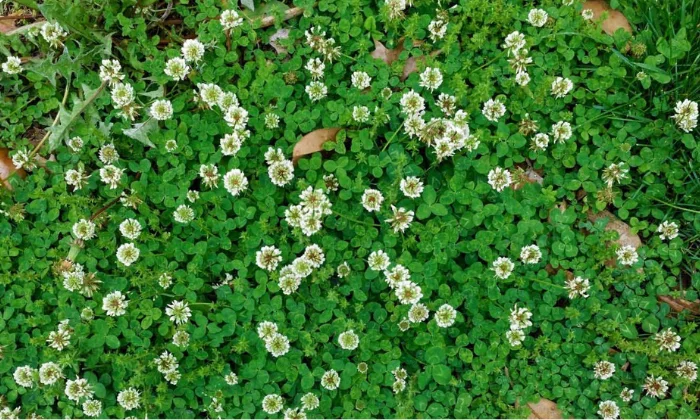A lush, green lawn is a source of pride for homeowners, but achieving and maintaining that perfect turf can be a challenge. One eco-friendly and low-maintenance solution gaining popularity is integrating clover into existing lawns. In this guide, brought to you by Robert Complete Care, we’ll explore the benefits of planting clover, step-by-step instructions on how to do it, and tips for maintaining a vibrant and resilient lawn.
Benefits of Planting Clover
Drought Resistance:
Clover has a remarkable ability to withstand drought conditions. Its deep roots help it access water even during dry spells, making it an excellent addition to your lawn for areas prone to water scarcity.
Nitrogen Fixation:
One of the key advantages of clover is its ability to fix nitrogen in the soil. This means it forms a symbiotic relationship with nitrogen-fixing bacteria, enriching the soil with this essential nutrient. As a result, the surrounding grass benefits from increased nitrogen levels, promoting healthier and greener growth.
Low Maintenance:
Unlike traditional grass varieties, clover is low-maintenance. It requires less water, fertilizer, and mowing. This makes it an ideal choice for those looking to reduce their environmental impact and spend less time on lawn care.
Resilience to Foot Traffic:
Clover is more resilient to foot traffic than many grass varieties. It can withstand the pressure of people and pets playing on the lawn, making it an excellent choice for families with active lifestyles. Robert Complete Care also provides Lawn Care service.
Step-by-Step Guide to Planting Clover in Your Lawn
Assess Your Lawn:
Before introducing clover, assess the current state of your lawn. Identify any areas with poor soil quality, excessive shade, or other issues that may affect clover growth. Understanding your lawn’s conditions will help you plan accordingly.
Choose the Right Clover Variety:
There are different types of clover, with white clover (Trifolium repens) being a popular choice for lawns. Select a variety that suits your climate and soil conditions. Consult with your local garden center for recommendations.
Prepare the Soil:
To ensure successful clover establishment, prepare the soil by removing debris, thatch, and weeds. Loosen the top layer of soil to create a favorable environment for clover seeds to germinate.
Seed Application:
Follow the recommended seeding rate for the clover variety you’ve chosen. Mix the seeds with sand to achieve an even distribution and broadcast them over the prepared soil. Lightly rake the area to cover the seeds with a thin layer of soil.
Watering and Germination:
Water the newly seeded area thoroughly and keep the soil consistently moist until the clover seeds germinate. This may take a few weeks, so be patient and monitor the soil moisture regularly.
Establishment Period:
Allow the clover to establish itself for at least 6-8 weeks before resuming regular mowing. During this period, mow your existing grass at a slightly higher height to promote coexistence with the developing clover.
Regular Maintenance:
Once established, clover requires minimal maintenance. Mow the lawn as needed, keeping the height between 2-4 inches. Clover can tolerate lower mowing heights, but maintaining a slightly taller lawn helps retain moisture and promotes overall lawn health.
Tips for Maintaining a Clover-Infused Lawn
Balanced Fertilization
While clover adds nitrogen to the soil, it’s essential to maintain a balanced fertilizer regimen for the overall health of your lawn. Perform soil tests periodically to assess nutrient levels and adjust your fertilization program accordingly.
Adequate Watering
Though clover is drought-resistant, it still benefits from consistent moisture. Ensure your lawn receives sufficient water during dry periods, especially during the establishment phase.
Regular Mowing
Keep your lawn well-maintained by mowing regularly. Adjust your mower height to accommodate both grass and clover, promoting an even and healthy lawn.
Weed Control
While clover suppresses some weeds, it’s important to manage invasive species that may compete for resources. Spot-treat weeds as needed to maintain a thriving lawn.
Conclusion
Integrating clover into your existing lawn is a sustainable and practical approach to achieving a beautiful and resilient outdoor space. By following the step-by-step guide provided by Robert Complete Care and implementing the maintenance tips, you’ll not only enjoy the benefits of a vibrant lawn but also contribute to a more eco-friendly and low-maintenance landscape. Embrace the beauty of clover, and let Robert Complete Care guide you towards a greener and healthier lawn. For any inquiries or assistance, please do not hesitate to contact us.
FAQs
Q1: Why Should I Consider Planting Clover In My Existing Lawn?
A1: Planting clover in your lawn offers numerous benefits, including drought resistance, nitrogen fixation, low maintenance, and resilience to foot traffic. It enriches the soil, reduces the need for excessive watering and fertilizers, and provides a lush, eco-friendly alternative to traditional grass.
Q2: Which Variety Of Clover Is Best For My Lawn?
A2: White clover (Trifolium repens) is a popular choice for lawns. However, the best variety depends on your specific climate and soil conditions. Consult with your local garden center or landscaping professional for personalized recommendations.
Q3: How Do I Prepare My Lawn For Clover Planting?
A3: Start by assessing your lawn’s current condition. Remove debris, thatch, and weeds, and loosen the top layer of soil. This creates an optimal environment for clover seeds to germinate. Follow our step-by-step guide for detailed instructions.
Q4: Can I Plant Clover In Shaded Areas Of My Lawn?
A4: While clover prefers sunlight, it can tolerate partial shade. If your lawn has shaded areas, choose a clover variety that is suitable for such conditions. Keep in mind that optimal growth occurs in areas with at least moderate sunlight.
Q5: How Often Should I Water My Clover-Infused Lawn?
A5: Clover is drought-resistant, but it benefits from consistent moisture, especially during the establishment phase. Water the lawn as needed, ensuring the soil remains consistently moist. Adjust the watering frequency based on weather conditions.
Q6: Do I Need To Fertilize My Lawn After Planting Clover?
A6: Clover adds nitrogen to the soil, reducing the need for excessive fertilization. However, it’s essential to perform periodic soil tests to assess nutrient levels. Adjust your fertilization program accordingly to maintain a balanced nutrient profile.
Q7: Can I Still Have A Well-Maintained Lawn With Clover?
A7: Absolutely. Clover requires minimal maintenance. Regular mowing, at a slightly higher height, is recommended. This promotes a healthy coexistence between the existing grass and clover. Follow our maintenance tips for a well-groomed and vibrant lawn.
Q8: Will Clover Attract Pests Or Insects?
A8: Clover generally attracts beneficial insects like bees while repelling some harmful pests. It contributes to a balanced ecosystem in your lawn. However, like any plant, occasional pest issues may occur. Monitor your lawn and address any pest problems promptly.


